Gaurav Srivastava
DEBATE, TRAIN, EVOLVE: Self Evolution of Language Model Reasoning
May 21, 2025Abstract:Large language models (LLMs) have improved significantly in their reasoning through extensive training on massive datasets. However, relying solely on additional data for improvement is becoming increasingly impractical, highlighting the need for models to autonomously enhance their reasoning without external supervision. In this paper, we propose Debate, Train, Evolve (DTE), a novel ground truth-free training framework that uses multi-agent debate traces to evolve a single language model. We also introduce a new prompting strategy Reflect-Critique-Refine, to improve debate quality by explicitly instructing agents to critique and refine their reasoning. Extensive evaluations on five reasoning benchmarks with six open-weight models show that our DTE framework achieve substantial improvements, with an average accuracy gain of 8.92% on the challenging GSM-PLUS dataset. Furthermore, we observe strong cross-domain generalization, with an average accuracy gain of 5.8% on all other benchmarks, suggesting that our method captures general reasoning capabilities.
Towards Reasoning Ability of Small Language Models
Feb 17, 2025Abstract:Reasoning has long been viewed as an emergent property of large language models (LLMs), appearing at or above a certain scale ($\sim$100B parameters). However, recent studies challenge this assumption, showing that small language models (SLMs) can also achieve competitive reasoning performance. SLMs are increasingly favored for their efficiency and deployability. However, there is a lack of systematic study on the reasoning abilities of diverse SLMs, including those trained from scratch or derived from LLMs through quantization, pruning, and distillation. This raises a critical question: Can SLMs achieve reasoning abilities comparable to LLMs? In this work, we systematically survey, benchmark, and analyze 72 SLMs from six model families across 14 reasoning benchmarks. For reliable evaluation, we examine four evaluation methods and compare four LLM judges against human evaluations on 800 data points. We repeat all experiments three times to ensure a robust performance assessment. Additionally, we analyze the impact of different prompting strategies in small models. Beyond accuracy, we also evaluate model robustness under adversarial conditions and intermediate reasoning steps. Our findings challenge the assumption that scaling is the only way to achieve strong reasoning. Instead, we foresee a future where SLMs with strong reasoning capabilities can be developed through structured training or post-training compression. They can serve as efficient alternatives to LLMs for reasoning-intensive tasks.
From Features to Transformers: Redefining Ranking for Scalable Impact
Feb 05, 2025Abstract:We present LiGR, a large-scale ranking framework developed at LinkedIn that brings state-of-the-art transformer-based modeling architectures into production. We introduce a modified transformer architecture that incorporates learned normalization and simultaneous set-wise attention to user history and ranked items. This architecture enables several breakthrough achievements, including: (1) the deprecation of most manually designed feature engineering, outperforming the prior state-of-the-art system using only few features (compared to hundreds in the baseline), (2) validation of the scaling law for ranking systems, showing improved performance with larger models, more training data, and longer context sequences, and (3) simultaneous joint scoring of items in a set-wise manner, leading to automated improvements in diversity. To enable efficient serving of large ranking models, we describe techniques to scale inference effectively using single-pass processing of user history and set-wise attention. We also summarize key insights from various ablation studies and A/B tests, highlighting the most impactful technical approaches.
LiMAML: Personalization of Deep Recommender Models via Meta Learning
Feb 23, 2024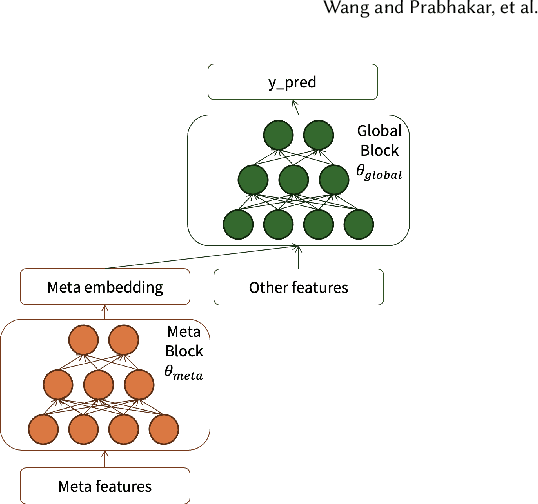
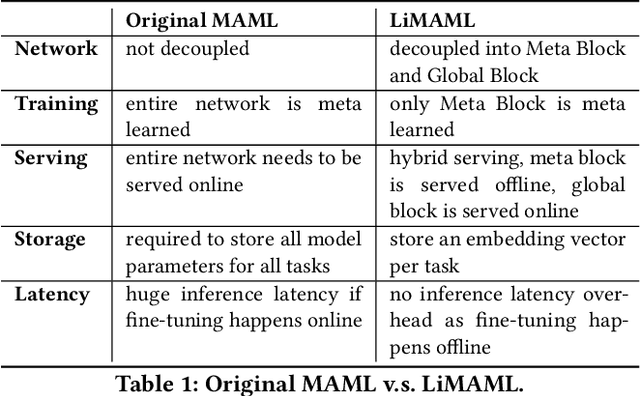
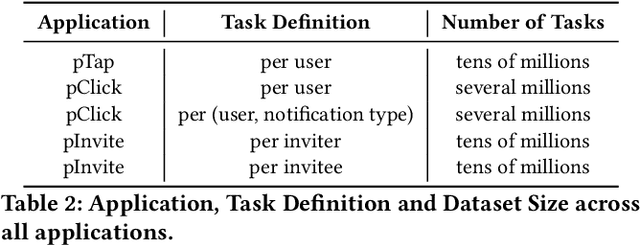

Abstract:In the realm of recommender systems, the ubiquitous adoption of deep neural networks has emerged as a dominant paradigm for modeling diverse business objectives. As user bases continue to expand, the necessity of personalization and frequent model updates have assumed paramount significance to ensure the delivery of relevant and refreshed experiences to a diverse array of members. In this work, we introduce an innovative meta-learning solution tailored to the personalization of models for individual members and other entities, coupled with the frequent updates based on the latest user interaction signals. Specifically, we leverage the Model-Agnostic Meta Learning (MAML) algorithm to adapt per-task sub-networks using recent user interaction data. Given the near infeasibility of productionizing original MAML-based models in online recommendation systems, we propose an efficient strategy to operationalize meta-learned sub-networks in production, which involves transforming them into fixed-sized vectors, termed meta embeddings, thereby enabling the seamless deployment of models with hundreds of billions of parameters for online serving. Through extensive experimentation on production data drawn from various applications at LinkedIn, we demonstrate that the proposed solution consistently outperforms the baseline models of those applications, including strong baselines such as using wide-and-deep ID based personalization approach. Our approach has enabled the deployment of a range of highly personalized AI models across diverse LinkedIn applications, leading to substantial improvements in business metrics as well as refreshed experience for our members.
Multi-view Sparse Laplacian Eigenmaps for nonlinear Spectral Feature Selection
Jul 29, 2023



Abstract:The complexity of high-dimensional datasets presents significant challenges for machine learning models, including overfitting, computational complexity, and difficulties in interpreting results. To address these challenges, it is essential to identify an informative subset of features that captures the essential structure of the data. In this study, the authors propose Multi-view Sparse Laplacian Eigenmaps (MSLE) for feature selection, which effectively combines multiple views of the data, enforces sparsity constraints, and employs a scalable optimization algorithm to identify a subset of features that capture the fundamental data structure. MSLE is a graph-based approach that leverages multiple views of the data to construct a more robust and informative representation of high-dimensional data. The method applies sparse eigendecomposition to reduce the dimensionality of the data, yielding a reduced feature set. The optimization problem is solved using an iterative algorithm alternating between updating the sparse coefficients and the Laplacian graph matrix. The sparse coefficients are updated using a soft-thresholding operator, while the graph Laplacian matrix is updated using the normalized graph Laplacian. To evaluate the performance of the MSLE technique, the authors conducted experiments on the UCI-HAR dataset, which comprises 561 features, and reduced the feature space by 10 to 90%. Our results demonstrate that even after reducing the feature space by 90%, the Support Vector Machine (SVM) maintains an error rate of 2.72%. Moreover, the authors observe that the SVM exhibits an accuracy of 96.69% with an 80% reduction in the overall feature space.
Private and Efficient Meta-Learning with Low Rank and Sparse Decomposition
Oct 07, 2022
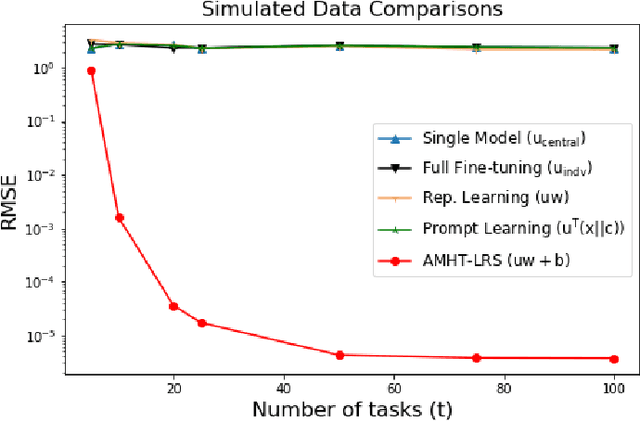
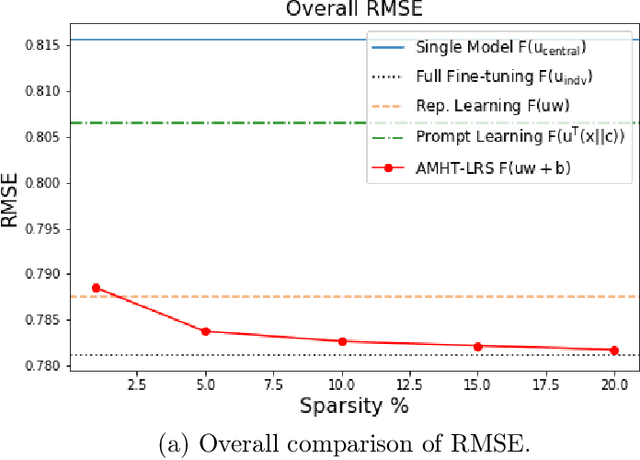
Abstract:Meta-learning is critical for a variety of practical ML systems -- like personalized recommendations systems -- that are required to generalize to new tasks despite a small number of task-specific training points. Existing meta-learning techniques use two complementary approaches of either learning a low-dimensional representation of points for all tasks, or task-specific fine-tuning of a global model trained using all the tasks. In this work, we propose a novel meta-learning framework that combines both the techniques to enable handling of a large number of data-starved tasks. Our framework models network weights as a sum of low-rank and sparse matrices. This allows us to capture information from multiple domains together in the low-rank part while still allowing task specific personalization using the sparse part. We instantiate and study the framework in the linear setting, where the problem reduces to that of estimating the sum of a rank-$r$ and a $k$-column sparse matrix using a small number of linear measurements. We propose an alternating minimization method with hard thresholding -- AMHT-LRS -- to learn the low-rank and sparse part effectively and efficiently. For the realizable, Gaussian data setting, we show that AMHT-LRS indeed solves the problem efficiently with nearly optimal samples. We extend AMHT-LRS to ensure that it preserves privacy of each individual user in the dataset, while still ensuring strong generalization with nearly optimal number of samples. Finally, on multiple datasets, we demonstrate that the framework allows personalized models to obtain superior performance in the data-scarce regime.
Training and challenging models for text-guided fashion image retrieval
Apr 23, 2022



Abstract:Retrieving relevant images from a catalog based on a query image together with a modifying caption is a challenging multimodal task that can particularly benefit domains like apparel shopping, where fine details and subtle variations may be best expressed through natural language. We introduce a new evaluation dataset, Challenging Fashion Queries (CFQ), as well as a modeling approach that achieves state-of-the-art performance on the existing Fashion IQ (FIQ) dataset. CFQ complements existing benchmarks by including relative captions with positive and negative labels of caption accuracy and conditional image similarity, where others provided only positive labels with a combined meaning. We demonstrate the importance of multimodal pretraining for the task and show that domain-specific weak supervision based on attribute labels can augment generic large-scale pretraining. While previous modality fusion mechanisms lose the benefits of multimodal pretraining, we introduce a residual attention fusion mechanism that improves performance. We release CFQ and our code to the research community.
VisualTextRank: Unsupervised Graph-based Content Extraction for Automating Ad Text to Image Search
Aug 05, 2021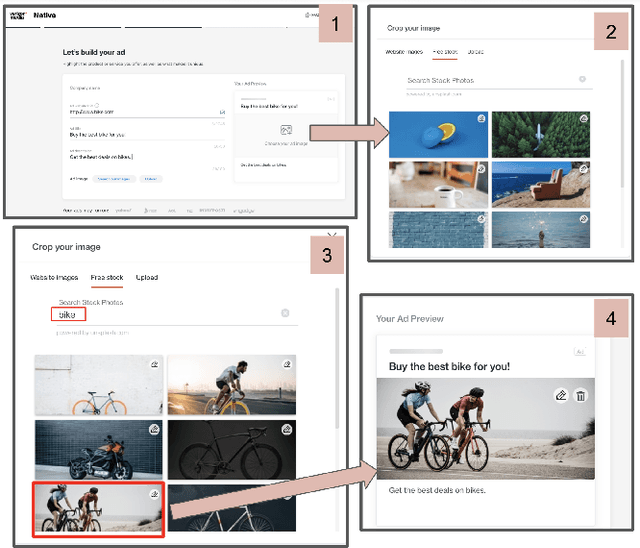
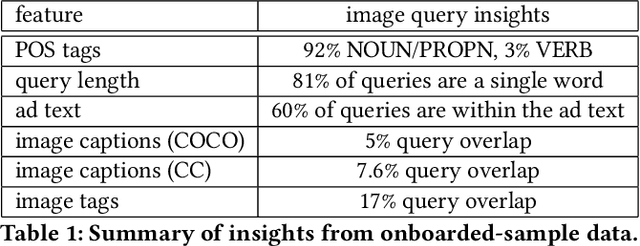

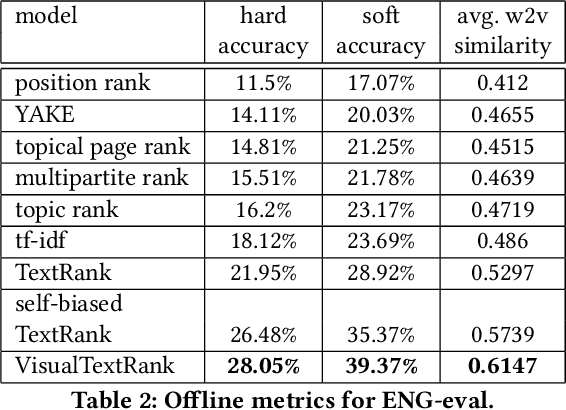
Abstract:Numerous online stock image libraries offer high quality yet copyright free images for use in marketing campaigns. To assist advertisers in navigating such third party libraries, we study the problem of automatically fetching relevant ad images given the ad text (via a short textual query for images). Motivated by our observations in logged data on ad image search queries (given ad text), we formulate a keyword extraction problem, where a keyword extracted from the ad text (or its augmented version) serves as the ad image query. In this context, we propose VisualTextRank: an unsupervised method to (i) augment input ad text using semantically similar ads, and (ii) extract the image query from the augmented ad text. VisualTextRank builds on prior work on graph based context extraction (biased TextRank in particular) by leveraging both the text and image of similar ads for better keyword extraction, and using advertiser category specific biasing with sentence-BERT embeddings. Using data collected from the Verizon Media Native (Yahoo Gemini) ad platform's stock image search feature for onboarding advertisers, we demonstrate the superiority of VisualTextRank compared to competitive keyword extraction baselines (including an $11\%$ accuracy lift over biased TextRank). For the case when the stock image library is restricted to English queries, we show the effectiveness of VisualTextRank on multilingual ads (translated to English) while leveraging semantically similar English ads. Online tests with a simplified version of VisualTextRank led to a 28.7% increase in the usage of stock image search, and a 41.6% increase in the advertiser onboarding rate in the Verizon Media Native ad platform.
Minimizing Area and Energy of Deep Learning Hardware Design Using Collective Low Precision and Structured Compression
Apr 19, 2018
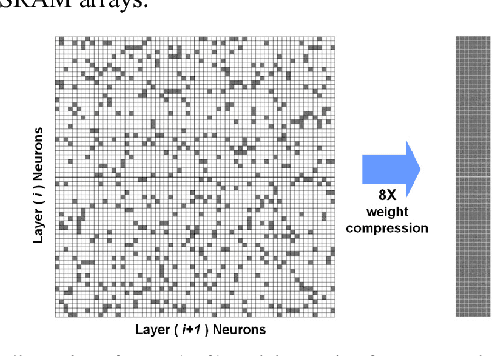
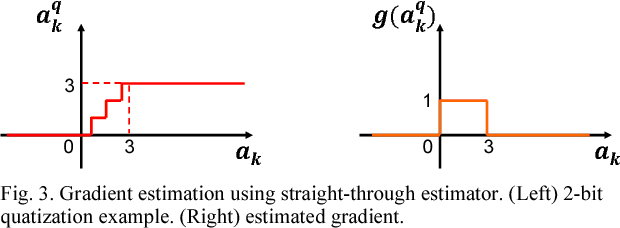
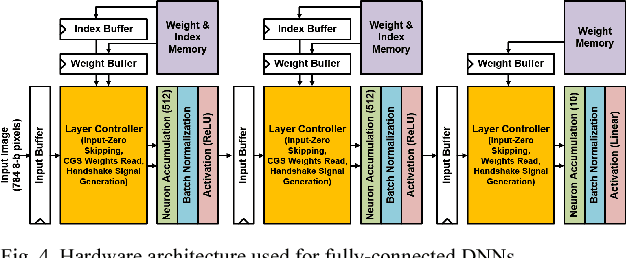
Abstract:Deep learning algorithms have shown tremendous success in many recognition tasks; however, these algorithms typically include a deep neural network (DNN) structure and a large number of parameters, which makes it challenging to implement them on power/area-constrained embedded platforms. To reduce the network size, several studies investigated compression by introducing element-wise or row-/column-/block-wise sparsity via pruning and regularization. In addition, many recent works have focused on reducing precision of activations and weights with some reducing down to a single bit. However, combining various sparsity structures with binarized or very-low-precision (2-3 bit) neural networks have not been comprehensively explored. In this work, we present design techniques for minimum-area/-energy DNN hardware with minimal degradation in accuracy. During training, both binarization/low-precision and structured sparsity are applied as constraints to find the smallest memory footprint for a given deep learning algorithm. The DNN model for CIFAR-10 dataset with weight memory reduction of 50X exhibits accuracy comparable to that of the floating-point counterpart. Area, performance and energy results of DNN hardware in 40nm CMOS are reported for the MNIST dataset. The optimized DNN that combines 8X structured compression and 3-bit weight precision showed 98.4% accuracy at 20nJ per classification.
An Analysis of Random Projections in Cancelable Biometrics
Nov 14, 2014



Abstract:With increasing concerns about security, the need for highly secure physical biometrics-based authentication systems utilizing \emph{cancelable biometric} technologies is on the rise. Because the problem of cancelable template generation deals with the trade-off between template security and matching performance, many state-of-the-art algorithms successful in generating high quality cancelable biometrics all have random projection as one of their early processing steps. This paper therefore presents a formal analysis of why random projections is an essential step in cancelable biometrics. By formally defining the notion of an \textit{Independent Subspace Structure} for datasets, it can be shown that random projection preserves the subspace structure of data vectors generated from a union of independent linear subspaces. The bound on the minimum number of random vectors required for this to hold is also derived and is shown to depend logarithmically on the number of data samples, not only in independent subspaces but in disjoint subspace settings as well. The theoretical analysis presented is supported in detail with empirical results on real-world face recognition datasets.
 Add to Chrome
Add to Chrome Add to Firefox
Add to Firefox Add to Edge
Add to Edge